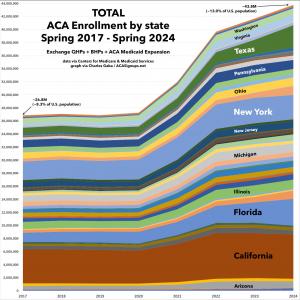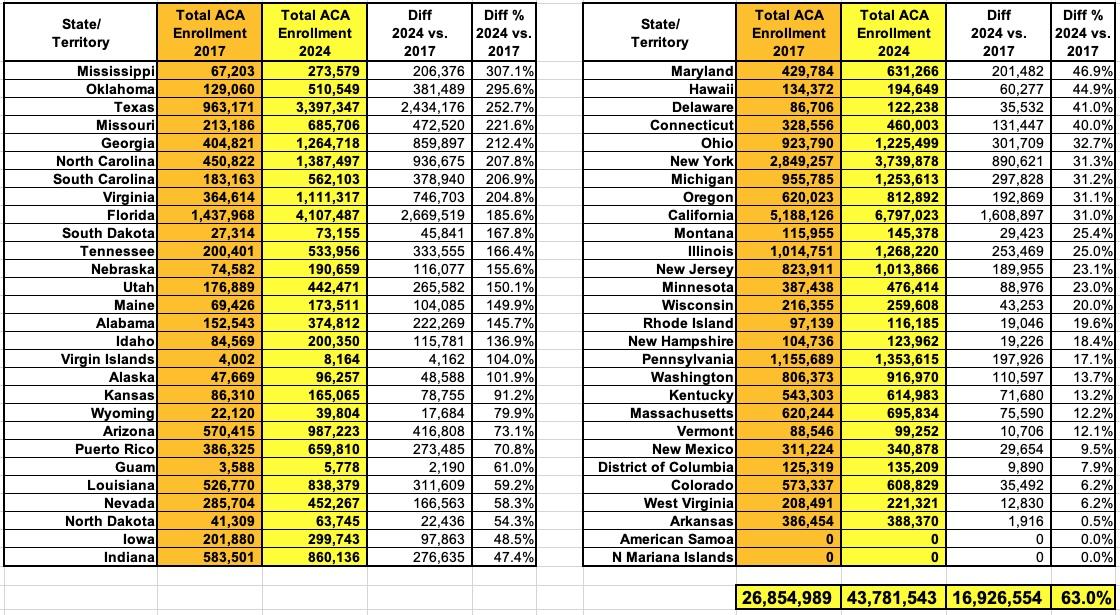Trump & MAGA can do plenty of damage to the #ACA w/out actually repealing it...but there's 44 million reasons why they might proceed w/caution after all.

Over at the JAMA Network, KFF Executive VP for health policy Larry Levitt has a piece which lays out the most likely actions (or in one case, lack of action) that the incoming Trump Administration & Republican-controlled Congress will take now that they have a second shot at repealing the Affordable Care Act:
With many tax cuts from the 2017 Tax Cuts and Jobs Act expiring at the end of 2025, a high-profile Congressional debate over extending those tax reductions and enacting new ones is likely. There will be pressure from some in Congress for spending cuts to help pay for those tax cuts. Trump has said that Social Security and Medicare cuts are off the table, and defense reductions are unlikely as well. That means almost half of federal spending would be protected from cuts, leaving Medicaid, which is the next largest source of federal spending, and the ACA as prime targets for spending cuts. The math is inescapable.
An ACA “repeal and replace” debate may not occur such as in 2017, which ended with a memorable thumbs down from Senator John McCain. But outright repeal of the ACA is not necessary to produce significant policy changes that would reduce federal health spending and, as a result, increase the number of uninsured individuals, and put pressure on state budgets.
Levitt points out that by far the easiest action the incoming GOP trifecta can take is not to take action...namely, to allow the upgraded ACA financial subsidies provided by the Inflation Reduction Act to simply expire at the end of 2025, as they're currently scheduled to do.
As I've been pointing out in my ongoing state-by-state series, this would have devastating consequences for millions of Americans who would see their net premiums skyrocket up to 10x or more higher. This was confirmed just yesterday by the Congressional Budget Office, which projects that not extending the IRA subsidies beyond 2025 will result in 3.8 million people losing healthcare coverage and unsubsidized premiums increasing by nearly 8% per year on top of the loss of subsidies and whatever the normal annual rate hikes would otherwise be.
Levitt then goes on to look at the bigger prize for the GOP: Medicaid.
Although Trump was silent on Medicaid during the 2024 campaign, his budget proposals during his first presidential administration included plans to cap federal spending on Medicaid and convert the ACA into a block grant to states. If those plans had been approved by Congress, they would have reduced federal spending for health care by more than $1 trillion over a decade. In his previous term, Trump also encouraged states to add work requirements to Medicaid through waivers.
The Project 2025 plan, prepared by the Heritage Foundation and a coalition of conservative groups, recommends changes to Medicaid including block grants, an aggregate cap on federal spending, a per-capita cap, or a change in the rate at which spending obligations are shared with states.
The Paragon Health Institute (a think tank that includes former Trump administration officials) has proposed reducing the federal match rate for Medicaid enrollees made eligible by the ACA to the standard Medicaid match rate. That seemingly simple change, which could be accomplished with small tweaks to legislative language, would have far-reaching effects.
...The CBO anticipates that some states would continue to cover ACA expansion enrollees to make up for the lost federal revenues, which would represent a big hit to state budgets, but others would not.
In fact, there are 9 states which would be legally required to kill Medicaid expansion if the federal match rate is reduced to anything less than 90%:
More than 3 million adults in nine states would be at immediate risk of losing their health coverage should the GOP reduce the extra federal Medicaid funding that’s enabled states to widen eligibility, according to KFF, a health information nonprofit that includes KFF Health News, and the Georgetown University Center for Children and Families. That’s because the states have trigger laws that would swiftly end their Medicaid expansions if federal funding falls.
The states are Arizona, Arkansas, Illinois, Indiana, Montana, New Hampshire, North Carolina, Utah, and Virginia.
(Actually, Arizona's trigger would kick in if it fell below 80%). Thankfully, my home state of Michigan rescinded its trigger law last year...but the massive funding gap would still have to be made up by the state, which would still put it at risk of being killed or weakened.
As deeply concerned as I am about one or both of the above things happening, there's two reasons to keep at least a bit of hope:
First, because Trump and the GOP no doubt remember how massive the midterm backlash against the 2017 Repeal/Replace debacle was in the 2018 midterms.
Second, because the ACA is far more popular AND provides healthcare coverage for far more people today than it did in 2017.
According to the ongoing KFF tracking poll, in December 2016 (just before Trump took office the first time), the ACA was 3 points underwater in favorability, with 43% favorable vs. 46% unfavorable opinions nationally.
As of April 2024, the ACA had a 62% favorable vs. 37% unfavorable rating...+25, and up 28 points from 8 years earlier.
It's amazing what experiencing the real world impact of a global pandemic along with more generous financial assistance can have on a law's approval rating.
Here's a table breaking out the total number of Americans with healthcare coverage directly provided by the Affordable Care Act today vs. in early 2017. This includes effectuated ACA exchange policies plus Medicaid expansion enrollment plus Basic Health Plan (BHP) coverage (the latter is available in Minnesota, New York and, since August, Oregon only):
In early 2017 during the Repeal/Replace debacle, the ACA provided healthcare coverage for less than 27 million people...8.3% of the U.S. population. Today it provides coverage for 63% more people...nearly 44 million, or around 13% of the total population. Messing with it will mean messing with a lot more people this time around.
Sort the states by which ones have seen the greatest increase in ACA coverage since 2017 and something else quickly becomes apparent: 12 of the 13 highest on the list are red states, which means that decimating the ACA will hurt MAGA country the hardest. Of course, 6 of those 12 never expanded Medicaid in the first place, so the biggest damage to those would be the loss of IRA subsidies, but my point remains:
I know Trump doesn't care and neither do a lot of MAGA Republicans, but I still have to imagine this will give at least a handful of them in swing districts pause. I hope so, anyway.
Here's a more striking graphic depiction of just how much ACA coverage has grown since the last time Republicans had a serious shot at tearing it down:
How to support my healthcare wonkery:
1. Donate via ActBlue or PayPal
2. Subscribe via Substack.
3. Subscribe via Patreon.






